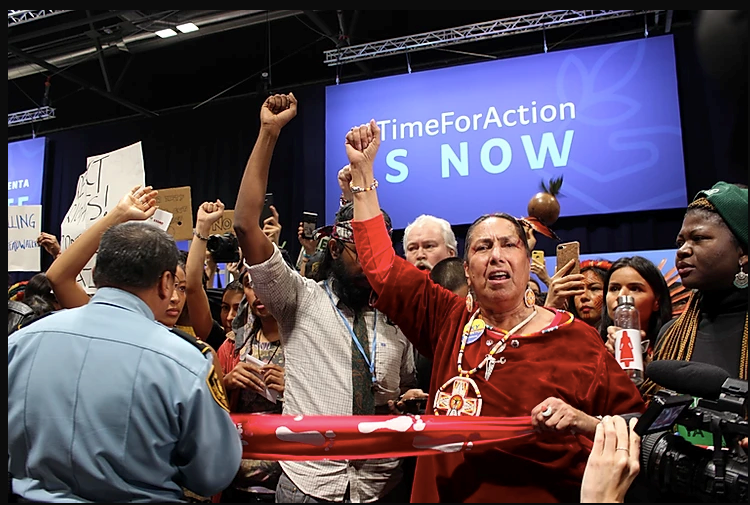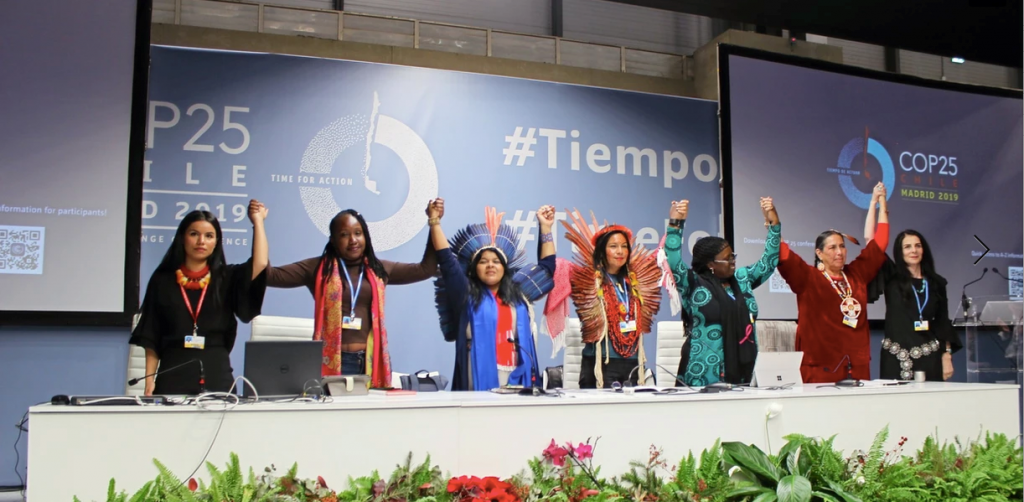The voice of indigenous women in climate action

Illustratrice : Yona @welcome_univers
29.06.2020
Written by Mathilde Vo
Translated by Chloé Lusven
Despite the fact that indigenous communities are the most vulnerable to climate change, women from these communities are willing to actively engage in climate action. Through their eloquence and protests, indigenous women radiate strength and determination, aiming to put the indigenous cause at the heart of climate related negotiations.
At COP25 in Madrid in December 2019, Nina Gualinga, an indigenous activist from the Kichwa community from Sarayaku in the Ecuadorian Amazon declared: «fighting climate change means listening to the Earth and that means listening to indigenous peoples who have been protecting these lands (…) If we don’t listen to indigenous peoples, if we don’t listen to indigenous women, we are not going to get out of this crisis» [1].
Nina Gualinga emphasizes the need to include indigenous communities in climate action. She insists on how important indigenous peoples’ knowledge of nature and the environment is. On that same topic, the GIEC (a group of intergovernmental experts on climate evolution) stated that «indigenous knowledge, being local and traditional, is a prime resource for adaptation to climate change»[2]. Moreover, research has found that indigenous peoples are used to adapting to the challenges of climate change thanks to their ancestral knowledge, which makes them more resilient [3].
Because they live so close to nature, these communities are very active in the fight against climate change. Their knowledge, and how important it is, have been emphasized in 2015 by the Paris Agreement, and indigenous peoples’ participation to reaching the sustainable development goals by 2030 was backed by the Sustainable Development Program [4].
These peoples living closest to nature are on the front lines of climate change and its effects
Although the indigenous cause has been taken into account in international treaties and charters, these communities are keeping on underlining the urgency of the current climate situation. Indeed, the call to action has been put forward in many speeches made by indigenous female activists during COP25. On December 11th, 2019, the demonstration that took place at the conference illustrated the urgency to take action as soon as possible. This movement also denounced the responsibility of the biggest polluters, such as the USA. Leading the protest with her fist raised in the air was a female activist, Casey Camp from the Native American Ponca tribe, representing indigenous women’s leadership in the fight against climate change. Her devotion to the cause is something worth highlighting.

Source : Photo by WECAN International, “Women for Climate Justice – Leading Solutions on the Frontlines of Climate Change” Event, December 11th, 2019
Although adapting to one’s environment is ancestral knowledge to indigenous people, climate change is by definition new and unpredictable. As Minnie Degawan, director of the indigenous and traditional peoples program at Conservation International says: “indigenous people have always faced the changing of the environment. Climate change is different. It happens at a much faster rate and has a greater impact, making it very difficult for indigenous peoples to adapt” [5]. Numerous indigenous communities are seeing their way of life being challenged by climate change. Indeed, consequences such as the ice melting (in Alaska for example) or the disappearance of their means of subsistence forces communities to migrate.
Human exploitation of resources: a leading cause of climate change
However, climate change is not the only reason why the indigenous peoples’ way of life is threatened. Industrial exploitation is the main cause of the deforestation of the Amazon, which constitutes one of the most important factor of climate change. During the event organized by WECAN at COP25, Nina Gualinga, an activist from the Kichwa community, stated that a government-sponsored oil company “went to her community’s territory and tortured her friends and family” [6]. She added that, in the fight between the oil industry and indigenous communities, women from her community refused to give up to industrialization and stepped in as true protectors of their territory and forest.
Women as guardians of the forest
In Vietnam, women from indigenous communities became guardians of the forest [7]. They are the ones that interact with it the most, through the gathering of wood and other forest resources. Thus, these women are able to identify illegal activities taking place and to raise the alarm, which makes them key players in forest resources management. Indigenous women’s knowledge allows them to take a stand in their communities but also in the international arena. In a similar way, within the Masai community in Tanzania, women have become protectors of a river. According to Masai community member Naijelijeli Tipap’s testimony [8], women have revived a river threatened by drought using their knowledge. They convinced the chief that they could preserve the river by protecting the trees surrounding it. They also planted more trees in order to make accessing the river more difficult to allow it to get back to its natural state.
Women and nature as one
These women’s will to become the symbol of protecting nature and their communities is not random. In addition to managing natural resources, indigenous women have a close connection to nature, as we can see from the echoes of ecofeminist theories present in their speeches. For example, during a demonstration lead by indigenous women in front of the American embassy in Madrid, Niria Alicia from the Mexica nation (descendants of the Mexican Aztecs) declared: «when you talk about violence against Mother Nature, you talk about violence against women»[9]. For these female activists, women and nature are one and the same.
In addition to denouncing the massive exploitation of natural resources, indigenous women also plead for the protection of their communities in face of the violence they suffer. During COP25, Sonia Guajajara, an Amazonian activist, paid homage to two indigenous leaders who were murdered [10] including Paulo Paulino Guajajara, the guardian of the Amazonian forest, killed by lumber traffickers. Through the slogan “Not one more drop of indigenous blood”, the activist refers to all indigenous protectors of the forests.
Although the 2015 Paris Agreement mention indigenous peoples’ rights protection, the true steps forward have been made by the new Action Plan for Gender Equality passed by COP25 in December 2019. Indeed, this decision requires that indigenous peoples’ rights have to be promoted and gender equality has to be enforced.

Source : Photo by WECAN International, “Women for Climate Justice – Leading Solutions on the Frontlines of Climate Change” Event, December 11th, 2019
It also means that the countries that signed it have to keep on promoting indigenous peoples’ rights in climate action. Furthermore, it has to be noted that this breakthrough was made possible by indigenous women’s commitment to stand up to ruling politicians. Lastly, during the civil society session of COP25, activist Kera Sherwood-O’Reagan from New Zealand’s Mauri tribe defended the indigenous cause by denouncing the states inaction. She said: «We are experts on climate. We are the kaitaki, the stewards of nature. We know the legitimacy of our voices and it’s about time you recognize it too. Hear our stories. Learn our histories. Stop taking up space with your false solutions and get out of our way»[11].
Sources
[1] Événement “Women for Climate justice : leading solutions on the frontlines of climate change” COP25 à Madrid, 11 décembre 2019
[2] GIEC, 2014: « Summary for Policymakers» in Climate Change 2014: Mitigation of Climate Change. Contributionof Working Group III to the Fifth Assessment Report of the Intergovernmental Panel on Climate Change [sous la direction de O. Edenhofer, R. Pichs-Madruga, Y. Sokona et al. (Cambridge and New York, Cambridge University Press
[3] M. Macchi, G. Oviedo, S. Gotheil et al.: Indigenous and traditional peoples and climate change: Issues paper (IUCN, 2008).
[4] R.K.Dhir, M.Oelz, M.Harsdorff, Les peoples autochtones et les changements climatiques, De victimes à agents de changement grâce au travail décent, Organisation international du travail, 2018.
[5] K.Price, Meet 3 indigenous women fighting to save the planet, 9 août 2019. Disponible sur : https://www.conservation.org/blog/meet-3-indigenous-women-fighting-to-save-the-planet
[6] Événement “Women for Climate justice : leading solutions on the frontlines of climate change” COP25 à Madrid, 11 décembre 2019
[7] V.T. Hien et al.: “Ethnic minority women in traditional forest management at Binh Son Village, Thai Nguyen Province, Vietnam”, in Tebtebba Foundation (dir. de pub.): Indigenous women, climate change and forests (Baguio City, 2011), pp. 247–266.
[8]Global Landscape Forum, 10 décembre 2019. Disponible sur : https://www.youtube.com/watch?v=wWf2pjDu698
[9]Indigenous Rising People. Vidéo disponible sur : https://www.facebook.com/watch/?ref=external&v=3096705260380004
[10] People power rises for climate justice at COP25 : WECAN International Analysis, 21 décembre 2019. Disponible sur : https://www.wecaninternational.org/post/people-power-rises-for-climate-justice-at-cop25
[11] “Stop taking up space with your false solutions” say furious activists at UN COP25, 16 décembre 2019. Disponible sur : https://www.theguardian.com/global/video/2019/dec/16/stop-taking-up-space-with-your-false-solutions-say-furious-activists-at-un-cop25
To quote this article : Mathilde Vo, “Indigenous women’s voices within climate action”, 29.06.2020, Gender in Geopolitics Institute.
